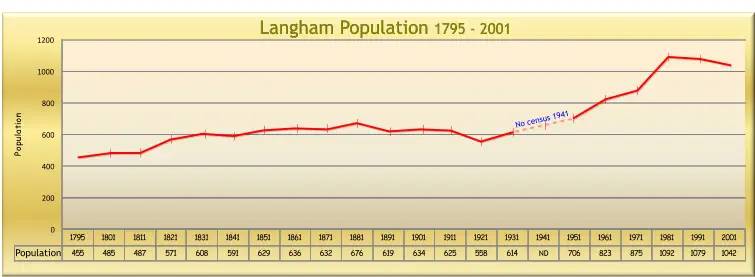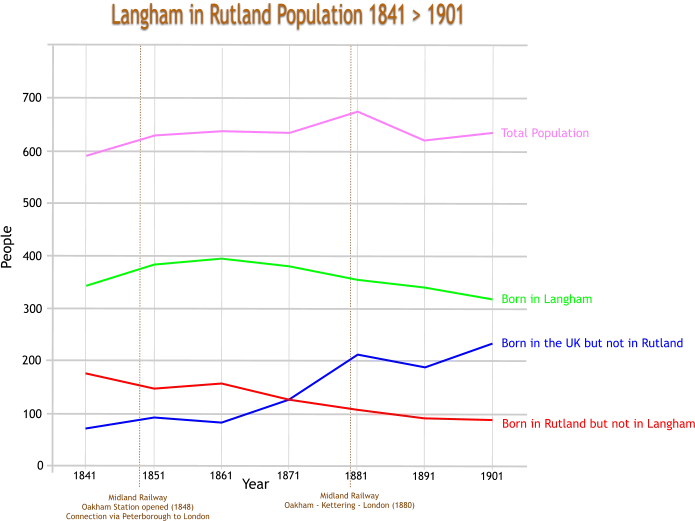The population of Langham continued to increase throughout the 19th c differing from the more generally held view
that village populations in the UK decreased during the second half of this period. Population in UK towns and cities
increased rapidly during the latter part of 18th c and during the 19th c. This population growth did not occur without
causing considerable anxiety, with many being concerned that such a rapid rise would soon lead to food shortages and
starvation. These concerns proved to be groundless but led the government to implement its first modern census in
1801 and each subsequent ten years to the present day, with the exception of 1941 during WWII.
The early censuses did return some information but it was not until 1841 that we see individual data per household,
this change was due to the way the data was collected. Each household was given a document which they were legally
required to complete on census night. Successive census required more detail to be given and this information was
usually collected by local people.
The national figures for 1851 show that approximately 40% of the workforce was now involved in some form of
manufacturing, whilst 25% were in services and 22% in agriculture.
The figures for Langham at the same census were 18.4% Skilled Trade or Manufacturing process, 12% in Services and
52% in agriculture. In fact it is likely that much of the skilled trade/manufacturing and the services were linked very
closely to agriculture as would be those employed in retail. It would be fair to say that the majority of the Langham
population would still be tied very closely to agriculture as the main form of employment.
What the data shows is that for most of the 19th c the village maintained a life style very much based on agriculture
and where life and occupations changed very little.
The arrival of the Midland Railway and its station in the nearby town of Oakham during 1848, and the opening in 1880
of a more direct route via Kettering to London began to bring about change. Affluent families moved into the village
and surrounding areas to take advantage of a country way of life with its fox hunting and other country pursuits,
commuting to the towns and cities during the week.




Langham Village History Group ~ © 1996 - 2025
Langham Census Data


The population of Langham continued to increase throughout the 19th c differing from the more generally held view
that village populations in the UK decreased during the second half of this period. Population in UK towns and cities
increased rapidly during the latter part of 18th c and during the 19th c. This population growth did not occur without
causing considerable anxiety, with many being concerned that such a rapid rise would soon lead to food shortages and
starvation. These concerns proved to be groundless but led the government to implement its first modern census in
1801 and each subsequent ten years to the present day, with the exception of 1941 during WWII.
The early censuses did return some information but it was not until 1841 that we see individual data per household,
this change was due to the way the data was collected. Each household was given a document which they were legally
required to complete on census night. Successive census required more detail to be given and this information was
usually collected by local people.
The national figures for 1851 show that approximately 40% of the workforce was now involved in some form of
manufacturing, whilst 25% were in services and 22% in agriculture.
The figures for Langham at the same census were 18.4% Skilled Trade or Manufacturing process, 12% in Services and
52% in agriculture. In fact it is likely that much of the skilled trade/manufacturing and the services were linked very
closely to agriculture as would be those employed in retail. It would be fair to say that the majority of the Langham
population would still be tied very closely to agriculture as the main form of employment.
What the data shows is that for most of the 19th c the village maintained a life style very much based on agriculture
and where life and occupations changed very little.
The arrival of the Midland Railway and its station in the nearby town of Oakham during 1848, and the opening in 1880
of a more direct route via Kettering to London began to bring about change. Affluent families moved into the village
and surrounding areas to take advantage of a country way of life with its fox hunting and other country pursuits,
commuting to the towns and cities during the week.




Langham Village History Group ~ © 1996 - 2025





























